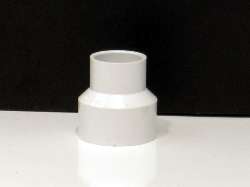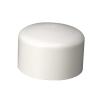This is a bell reducer:BrianMigs wrote:what does a bell reducer look like? and how can some people on here tell if certain parts are dwv, especially if its all ready painted over?
If a part is DWV, it should only say DWV and maybe Sch 40 on the fitting/pipe.
On fittings the writing is usually raised and can be read once painted over, with pipe, if you have enough layers of paint you probably can't read it.
Don't Worry about identifying DWV pipe and fittings, more pressure rated fittings.
To find out if a fitting is pressure rated, it should have 'NSF-PW' and it may also have Sch 40 (or 80,120 etc) on it. IIRC American fittings don't have a pressure rating on them, but if they have NSF-PW, you're okay, it will be rated.
For pipe, it should have 'NSF-PW Sch 40 (or 80,120, etc) XXXPSI @73F'
XXXPSI, is the pressure rating, it changes depending on the Schedule rating and the diameter of the pipe. The pipe may have a different temperature rating, but the most common say '@73F'.
The pipe may also have 'DWV" written on it, as long as the pipe has a pressure rating, e.g '300PSI @73F' you're okay.
If it doesn't have 'NSF-PW' or pressure rating, chances are it's DWV.
Edit:
This is a PRESSURE RATED PVC 90* bend:
This is a DWV PVC 90* bend, non-pressure rated:
As you can see, the difference is very obvious.
You can get fittings that look DWV, but I doubt you will find them at Home Depot or Lowes, usually they're only found online.
Not really.BrianMigs wrote:Is there a thread or something somewhere that will show me what all these different parts look like?
I'll list a few pressure rated fittings in pictures:
That's really all the important information about identifying American Pressure rated pipe.
I'll try and find a good section for it, if not i'll create my own.














